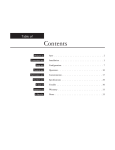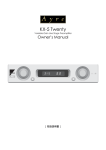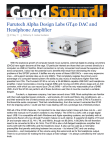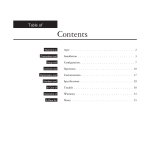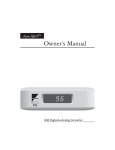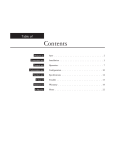Download Ayre Backlit Remote Owner`s manual
Transcript
Ayre AX-5 Owner’s Manual Integrated Amplifier Table of Contents Welcome to Ayre . . . . . . . . . . . . . . . . . . . . . . . 2 Connections and Installation . . . . . . . . . . . . . . . . . . . . 3 Setup and Configuration . . . . . . . . . . . . . . . . . . . 7 Controls and Operation . . . . . . . . . . . . . . . . . . . . 10 Optimization and Customization . . . . . . . . . . . . . . . . . . 17 Numbers and Specifications . . . . . . . . . . . . . . . . . . 28 In Case of Trouble . . . . . . . . . . . . . . . . . . . . . 29 Statement of Warranty . . . . . . . . . . . . . . . . . . . . 32 A Place for Notes . . . . . . . . . . . . . . . . . . . . . . 35 Welcome to Ayre To our North American customers, please be sure to mail your warranty registration card and photocopy of your original sales receipt within 30 days in order to extend the warranty to five years. Your Ayre AX-5 offers a significant advance in the musical performance of high-fidelity equipment. The warmth and immediacy of a live performance are apparent from the first listening. The combination of superb resolution and a natural, relaxed quality will draw you into the music, time and time again. This level of performance has been implemented using the highest level of workmanship and materials. You can be assured that the Ayre AX-5 will provide you a lifetime of musical enjoyment. Quick Start The Ayre AX-5 is extremely flexible and versatile. However, many of the features are primarily of interest to the advanced user. The information required to get started is contained in the following three chapters of this manual. The remaining chapters cover additional information that may be read at your leisure. 2 Connections and Installation The Ayre AX-5 is easy to use. The following guidelines will ensure that the installation goes smoothly. As shipped from the factory, none of the inputs are activated. The desired inputs are activated by assigning them names as described in the following chapter, “Setup and Configuration”. Location Do not stack the Ayre AX-5 directly with other components, as this may restrict the air flow or induce hum into the audio circuitry. A good location for your integrated amplifier is in an open-backed cabinet or on a shelf. The AX-5 produces a moderate amount of heat during operation. Be sure to provide at least three inches (75 mm) of air space above the amplifier. An adequate supply of air flow will avoid overheating the amplifier. The infrared beam will also travel through glass. The receiver for the remote control is behind the display lens on the front panel. A line of sight from the listening position will ensure maximum range. 3 Inputs When you have a choice, a balanced connection will offer slightly higher sound quality than a single-ended connection. The Ayre AX-5 offers four pairs of balanced inputs and two pairs of single-ended inputs. Balanced connections are made via three-pin XLR connectors, while single-ended connections are made with RCA connectors. In this modern era of diverse source components, it has become impractical to pre-label the inputs with the actual name of the source. The rear-panel inputs are labeled “1” through “6”. Make a written note of which source components are connected to which numbered input. The connected inputs will be named after AC power is applied to the AX-5 amplifier, as described in the chapter “Setup and Configuration”. Loudspeaker Outputs The heavy-duty output terminals of the Ayre AX-5 work best with speaker cables equipped with spade lugs. 4 The Ayre AX-5 drives the loudspeakers with balanced outputs. Since none of the output terminals are grounded, connecting any of them to ground may result in damage to the amplifier. Do not connect the loudspeaker outputs to any speaker switch-box, accessory, or test equipment that has a common ground connection. Tape Outputs The Ayre AX-5 provides tape outputs, allowing connection of the selected source component to a recording device or headphone amplifier. The tape outputs utilize balanced XLR connectors. Should it be necessary to connect a tape output to a single-ended component, high-quality adapters are available from your Ayre dealer. Turn the tape outputs off unless they are currently being used. This will completely disconnect the auxiliary components from the AX-5 (including the ground connection), eliminating the possibility of undesired ground loops or other interference. Unlike the loudspeaker outputs, the tape outputs will not convert the signal from a single-ended source to a true balanced signal. Instead, the “hot” signal will be present on pin 2 of the XLR and pins 1 and 3 will be grounded. This allows a balanced component connected to the tape outputs to internally perform the single-ended to balanced conversion without the need for adapters. 5 AC Power The AX-5 may be plugged directly into an unswitched wall outlet. Although proprietary RFI (radio-frequency interference) filtering is built into the amplifier, in some situations an AC power-line filter (such as those offered by Ayre) may provide additional sonic benefits. Break-In 100 to 500 hours of music played through the system will ensure full break-in. Due to the manufacturing processes used for the wires, capacitors, and circuit board materials, a break-in period is necessary for the amplifier to reach its full sonic potential. Each input uses a different physical path on the input circuit board. Therefore a separate break-in period is required for each input. 6 Setup and Configuration Due to the large number of available inputs (six) on the AX-5, activating only the desired inputs allows for simpler operation of the unit. If no inputs are activated, the amplifier will automatically enter the setup mode when AC power is applied. Only the active inputs will be included in the list of available source components. Activating Inputs (Basic Setup Menu) The desired inputs are activated simply by naming them. When AC power is first applied to the unit, the front panel will briefly display “ AX5” and “FWX” in sequence, where “FWX” indicates “Firmware Revision X”, where “X” is a letter from “A” to “Z”. AX5 FWX SET UP OFF 1 Assuming that none of the inputs have yet been configured, the unit will then automatically enter the setup mode and the front panel will display “SET UP” briefly. Then it will display “OFF 1”, (meaning input 1 is “off”) to allow the naming (activation) of the inputs. 7 OFF INx PC CD PH DVD SCD SSP DIG TNR AUX D/A DAT CDR CBL TV VCR LD DX5 C5X QB9 CX7 DX7 D1X EX 8 X X X X X X X X X X X X X X X X X X X X X X X X SU Refer to your notes describing which source components are connected to which numbered input. Use the right-hand knob to scroll to the desired numbered input (“OFF 1” through “OFF 6”). When you have reached the desired input number, use the left-hand knob to scroll through the list of available names (shown at the left). Selecting “ OFF” disables that input, while selecting any other name from the list will activate (enable) that input. Select a name describing the source connected to the chosen input, and it will automatically be entered into memory. The display will show the name has been assigned to the chosen input. Repeat the process of naming the remaining desired inputs. When all of the desired inputs have been named, press the left-hand button to exit the basic setup mode. The front panel will briefly display “EX SU” to indicate that the unit is exiting the set up mode. Then the unit will return to the low-power consumption mode, indicated by the green LED in the right-hand switch. Re-Entering Basic Setup Mode SET UP XXX 1 To re-enter the basic setup mode to make changes to the names of inputs, make sure that the amplifier is in the low-power consumption state (right-hand pushbutton lit green—please refer to the chapter “Controls and Operation” for additional information). Then press and hold the left-hand button for three seconds. The front panel will then display “SET UP” briefly, and then“XXX 1” where “XXX” is the name assigned to input 1. Advanced users may wish to use additional sophisticated input configuration options, including the creation of custom names for source components. Please refer to the chapter “Optimization and Customization” for further details on using the advanced setup mode. 9 Controls and Operation Included with the Ayre AX-5 is a remote-control handset. Illustrations of the controls on the amplifier are shown to the far left, and the buttons on the remote handset are on the near left. On/Off (1/0) The main power switch for the AX-5 is a rocker at the top center of the rear panel. This switch disconnects the unit completely from the AC power. When the amplifier is turned “off” none of the auxiliary functions (e.g., the AyreLink system communication and the tape outputs) are operable. After the unit is turned on, it may take perhaps 30 minutes or so to fully warm up and sound its best. Therefore a low-power consumption mode is also included. This allows the auxiliary functions to operate and also minimizes the warm-up time by keeping power applied to the audio circuitry. To reduce power consumption when not listening to music, bias current is removed from the output stage. 10 Volume Control The volume level may be controlled with either the right-hand knob or the remote-control handset, displaying the volume setting on the front panel. There are 46 individual levels, each with a step size of 1.5 dB, allowing for precise selection of the desired volume setting. If the volume control is advanced beyond the highest available level, the front panel will briefly display the message “MAX”. Mute/Low-Power Consumption The right-hand button on the AX-5 serves two functions—mute, and control of the low-power consumption mode. Mute A short press of the right-hand button (or the dedicated button on the remote handset) provides an easy way to temporarily turn the volume of the 11 AX-5 to “zero” while retaining the current volume setting in memory. Pressing either button a second time restores the volume to the previous level. When the mute function is activated, all five decimal points in the display will light up. Low-Power Consumption Mode Press and hold the right-hand front-panel button for three seconds (or a short press of the “1/0” remote button) to enter the low-power consumption mode. The audio and display will shut off, yet the tape output and AyreLink functions remain active. This mode is indicated by illuminating the green LED in the right-hand button. While in low-power consumption mode, the tape output is still active and will respond to changes of the input selector. A long press of the “1/0” remote button will place all AyreLinked components in your system into low-power consumption or standby mode. Input Select The desired source component may be selected with either the left-hand knob or the remote control handset, and the assigned name is displayed on the front panel. Although there are six total inputs on the Ayre AX-5, only the activated (named) inputs will be listed among the available sources. This greatly simplifies operation of the unit. 12 Tape Outputs/Basic Setup Mode The left-hand button on the AX-5 activates two functions—the tape outputs and the basic input setup mode. Tape Outputs The tape outputs may be controlled either by the left-hand button on the front panel, or from the remote handset. Pressing the button activates the tape outputs, and pressing it a second time will turn them off. When the tape outputs are activated, the red LED in the front-panel switch is illuminated. Turn the tape outputs off unless they are currently being used. This will completely disconnect the auxiliary components from the AX-5 (including the ground connection), eliminating the possibility of undesired ground loops or other interference. Basic Setup Mode While the AX-5 is in low-power consumption mode (green LED illuminated), pressing and holding the left-hand front-panel button for three seconds will enter the unit into the basic setup (input naming and activation) mode. Additional basic setup information is available in the chapter “Setup and Configuration”, while advanced setup information is available in the chapter “Optimization and Customization”. 13 Display Brightness The brightness of the front-panel display may be controlled via the remote control. There are three brightness levels and a “display off” setting. Each press of the remote control button scrolls through the four available brightness settings. A small blue light indicates that the display is turned off. When further commands are received, either from the front-panel buttons or the remote control, the normal display will be activated for a few seconds to confirm the command, and then the display will turn off again. Changing the display brightness of components linked via the AyreLink communication system will change the display brightness of all linked components. Remote Control The provided remote control handset will operate both the Ayre AX-5 amplifier as well as an Ayre disc player. A backlight is also provided to allow easy operation in a darkened listening room. Batteries The remote handset uses four AAA batteries. These are accessed by removing the two screws that hold the black end piece. The battery holder will slide out, and the batteries may be replaced. 14 Disc Player Configuration As shipped from the factory, the remote control handset is configured to operate the Ayre C-5xeMP disc player. The button with three horizontal lines operates the “Audio” function that selects between various soundtracks on a DVD disc. Please refer the C-5xeMP Owner’s Manual for additional details. 15 The remote handset may also be easily configured MP to operate either the Ayre CX-7e CD player, MP C-5xe Stereo Universal player, or DX-5 Universal A/V Engine, which each use different command sets. Please refer to the chapter “Optimization and Customization” for details. 16 Optimization and Customization In most audio systems, the AX-5 amplifier only requires that the desired inputs be activated by naming them. Each source component is clearly identified and only the connected inputs are displayed in the list of available source components. This is the basic setup mode. In certain installations it may be desirable to customize additional settings for each input by using the advanced setup mode. Advanced Setup Mode The advanced setup mode allows the following settings to be independently adjusted for each input: • Custom Name - for creating a custom name for source components • Gain Offset - for level matching of source components • Processor Pass-Through - for integration with a surround-sound processor • AyreLink - for automatic input selection of linked components • Reset - for resetting all of the input customizations to the factory defaults 17 SET UP XXX 1 CN GOS PP AL RST To enter the advanced setup mode, make sure that the amplifier is in the low-current consumption state (green LED illuminated on the right-hand button). Then press and hold the left-hand button for three seconds. This enters the unit into the basic setup mode. The display will briefly show “SET UP” and then display “XXX 1” where “XXX” is the name assigned to input 1. Use the right-hand knob to select which input (1 - 6) you wish to configure with advanced options. Then briefly press the right-hand button to enter the advanced menu level. The left-hand knob will select which setting you wish to configure for that input: • CN - Custom Name • GOS - Gain Offset • PP - Processor Pass-Through • AL - AyreLink • RST - Reset After you have selected the desired choice, press the right-hand button to enter the selection. 18 Custom Name A custom name (up to 3 characters) may be created as follows: 1) From the advanced set up menu, rotate the left-hand knob to scroll to the selection “ CN”. 2) Press the right-hand button to enter the next menu level. The current name will be displayed, with the selected character designated with a decimal point (cursor) after the character. The left hand knob selects the cursor position. 3) Use the right-hand knob to select the desired character. The character set includes A - Z, 0 - 9, a hyphen, and a blank. There are two instances of the blank character, one between each group of characters. The two blanks divide the groups of characters and make it easier to locate a blank character when desired. 4) After creating the desired custom name, press the left-hand button to back up to the previous level in the setup menu. Gain Offset Source components may have varying output levels. In order to maintain a more constant volume level when changing sources, the Ayre AX-5 allows a gain offset to be applied to each input. 19 GOS GOS GOS GOS GOS 0.0 1.5 3.0 4.5 6.0 The gain offset offers an adjustment from +0 dB to +6 dB in 1.5 dB increments. Therefore the source components with lower output levels may be boosted to match the source components with higher output levels. Once you have selected the “GOS” menu item with the left-hand knob, simply select the desired offset level with the right-hand knob. Changing the gain offset from +0 dB will affect the maximum displayed volume level. If the volume control is advanced beyond the highest available level, the front panel will briefly display the message “Max”. Processor Pass-Through When using the Ayre AX-5 in a surround-sound system, it is desirable to use the “Processor Pass-Through” mode. This allows your two-channel sources to be routed directly through the AX-5, avoiding the sonic degradation of most processors, and at the same time allows the front two channels of the theater system to integrate seamlessly with your main two-channel playback system. PP PP 20 OF On If you are using a surround-sound processor, connect the front left and right outputs of the processor to one of the inputs on the AX-5. When configuring that input, use the left-hand knob to select the “ PP” menu item and the right-hand knob to select “ On”. Press the left-hand button to return to the advanced setup menu. The chosen input is now programmed for Processor Pass-Through operation, disabling the now redundant volume control of the AX-5. When that input is selected, the AX-5 is set to the standard power amplifier gain (26 dB), and the volume is controlled directly from the surround-sound processor. The volume indicator of the AX-5 will display “PP” to show that the Processor Pass-Through mode has been selected for that input. The gain (“PP”) setting of the Processor Pass-Through mode will result in an excessively high sound level with a normal source component. Be sure to leave the “PP” setting to “OF” for all other source components to avoid possible damage to your loudspeakers. Selecting an input where the “PP” has been set to “On” will cause the stepper motors to rapidly move the internal rotary switches to the unity gain setting. This results in an audible “whirring” noise and is completely normal. The “whirring” noise will also be heard when reverting to an input where the “PP” is set to “OF”. AyreLink AyreLink provides for true “one-touch” operation of the entire music system. As explained in the chapter “Controls and Operation”, turning on a source component connected with AyreLink will automatically turn on all of the linked “downstream” components (i.e., integrated amplifiers and power amplifiers). In addition, the appropriate input on the AX-5 will also be automatically selected. 21 However, in certain extremely rare situations, it is possible that the AyreLink communication system will require adjustments to the configuration settings. To gain an understanding of these circumstances, it is necessary to understand how the AyreLink automatically selects the correct input on the AX-5. When any AyreLink source component is turned on, it broadcasts that information to the other linked components. Part of the transmitted information is an alphabetical code that identifies the source of the broadcast. For example, an AyreLink equipped CD player will transmit the code “ C”, a DVD player will transmit the code “D”, a phono amplifier will transmit the code “P”, a D/A converter will transmit the code “Q” and so forth. When the inputs of the AX-5 are activated by naming them, many of the common names will have an AyreLink alphabetical code automatically associated with it. For example, the input name “CD” is associated with the AyreLink code “C” by default. In this way, when an AyreLink-equipped CD player is turned on, the AX-5 will automatically select the input labeled “CD”. But if a system were to have more than one AyreLink-equipped CD player (we’re not sure why that would be the case, but it is certainly within the realm of possibility), the AX-5 would be unable to distinguish which CD player transmitted the command, and would therefore be unable to automatically select the correct input. Similarly, it is possible that the user wishes to create a custom name for the CD player input, for example, “ IN3”. 22 In this case there is no default AyreLink code that would select this input. To address these issues, the setup menu allows each named input to be associated with an AyreLink identification code. Once you have selected the “ AL” menu item with the left-hand knob, simply select the desired identification code (“ A” to “Z”, or “_” for “none”) with the right-hand knob. ALA . . ALZ Do not assign any single identification code to more than one input. Improper operation may result. The identification code transmitted by an AyreLink source component will be found in the owner’s manual for that unit. Reset RST RST OF On It is possible to reset all of the setup mode configuration items to their factory defaults by using the reset function. After entering the advanced setup mode, turn the left-hand knob to “RST” and turn the right-hand knob to “On”. Press the right-hand button to activate the "Reset" function. All inputs will revert to “ OFF”, all gain offsets will be restored to zero, all Processor Pass-Through settings will be restored to “ OF”, and all AyreLink codes will default to “_”, for “none”. The unit will then automatically enter the setup mode so that the desired inputs may be activated. 23 Overall Gain The volume control for the AX-5 amplifier comprises a 69 dB range. For most audio systems this will provide more than enough range, allowing for low-level late-night listening sessions as well as the ability to totally immerse yourself in your favorite music at high volumes. If you need to change the overall gain of your system, please contact your Ayre dealer. However, it is possible that in some systems that the overall gain will need to be adjusted upwards or downwards to provide the desired range of listening levels. For example, if the sensitivity of your loudspeakers is unusually low, it may be necessary to increase the system gain. Conversely, if you have extremely sensitive loudspeakers or source components with a very high output level, you may wish to decrease the system gain. Either change is easily accomplished with the Ayre AX-5, as there is a single resistor per channel that sets the overall gain range. This gain resistor is mounted in a terminal block and can be changed without the need for soldering. If you are also using a surround-sound processor in your system, changing the overall gain of the amplifier will require adjusting the gain of the remaining channels of your surround-sound processor to match. Remote Control As shipped from the factory, the supplied remote control handset is configured to also operate an Ayre C-5xeMP universal stereo disc player. It may also be 24 easily configured to operate an Ayre CX-7eMP CD player (or other disc player that utilizes the RC-5 remote control protocol), or also an Ayre DX-5 Universal A/V Engine. To change the remote control handset to operate the CX-7eMP, simply press the number button “7” five times in succession. (Please note that the “Audio” button used to select soundtracks on DVD discs will have no function in this configuration.) Press the number button “8” five times in succession to change the remote handset to operate the DX-5. To return the remote handset to operate the C-5xe MP again, press the number button “5” five times in succession. To ascertain the current configuration of the remote control handset, press the number button “0” five times in succession. The backlight illumination will flash five times to indicate that it is configured to operate the C-5xeMP, seven times to indicate that it is configured to operate the CX-7eMP, or eight times to indicate that it is configured to operate the DX-5. Trigger Control A trigger control allows one component to control the low-power consumption or the “Standby” state of another component. If there are no AyreLink source components available to control the operation of the AX-5 amplifier, it may be convenient to use the trigger control from a source component. The trigger signal from a source component will directly control the AX-5 amplifier. The AX-5 can 25 then in turn control amplifiers linked by the AyreLink communications system. Connect the AyreLink ports of your components in a daisy-chain fashion as described in the chapter “Connections and Installation” with the AX-5 at one end of the chain. The unused AyreLink port on the amplifier is then used as a trigger input. Rear view of AX-5 amplifier. An adapter cable must be fabricated to connect the trigger output of the control component to the AyreLink port of the AX-5 amplifier. The easiest way to do this is to remove the modular (RJ-11) connector from one end of a two-line telephone line cord. (This is the type of cord that connects the telephone set to the wall. A two-line cord will have four gold contacts on each connector.) Then attach the connector appropriate for the component with the trigger output. Please refer to the owner’s manual of that source component for details. The trigger voltage should be between +5 and +12 volts DC for proper operation. The current draw of the trigger input on the AyreLink port is less than 5 mA. There are two signaling methods that may be used; level and pulse. The AX-5 automatically senses which type of trigger signal is being sent and responds accordingly. A positive-going pulse of greater than 250 msec is treated as a level-sensitive trigger. Shorter pulses are treated as a pulse-sensitive trigger. The minimum detectable pulse length is 200 µsec. 26 During level-sensitive operation, applying a voltage to the trigger input will set the amplifier to the “Operate” mode. When the applied voltage drops to zero, the unit reverts to the low-power consumption mode. In the pulse-sensitive mode, a positive-going pulse will toggle the amplifier between the low-power consumption and “Operate” states, duplicating the action of the right-hand front-panel button when it is held for three seconds. The front-panel button remains operative when the trigger input is used. Therefore, using the front-panel button will put the amplifier out of “sync” with the trigger control device. When used with level-sensitive trigger operation, the next trigger action will automatically restore “sync”. However when using pulse-sensitive trigger operation, “sync” can only be restored by pressing the front-panel button a second time. 27 Numbers and Specifications Power Output Maximum Input Level Input Impedance XLR Input Polarity Gain 8 V rms – unbalanced inputs 16 V rms – balanced inputs 1 MΩ – unbalanced inputs 2 MΩ – balanced inputs (1 MΩ per phase) Pin 1 = Ground Pin 2 = Non-inverting (Positive) Pin 3 = Inverting (Negative) 32 dB (maximum, at volume level of “ 46”) Frequency Response DC - 250 kHz Power Consumption 48 watts in low-current consumption mode 230 watts in operating mode, no signal Dimensions Weight 28 125 watts per channel continuous into 8 ohms 250 watts per channel continuous into 4 ohms 17-¼" W x 18-¾" D x 4-¾" H 44 cm x 48 cm x 12 cm 46 pounds 21 kg In Case of Trouble The Ayre AX-5 provides comprehensive protection for both your amplifier and loudspeakers, including faults that may occur in your source components. Overheating If the unit is operated at high playback levels with insufficient ventilation, the internal temperature may become too high, triggering the thermal protection circuitry. In this case the amplifier will mute, the bias current to the output stage will be removed, the warning LED in the display will glow red, and the front-panel mute/low-power consumption button will be inoperative. The input selector characters will change to read “HOT” as long as the internal temperature remains too high. If overheating occurs, be sure to correct the cause before continuing to use the amplifier. Once the unit has cooled, the red warning LED will turn off, the green LED will light to return to the low-power consumption mode, but the “HOT” message will remain so that the error is known. To restore the unit to the normal operation mode, simply press the right-hand front-panel button. 29 Rail Fuses Four internal power supply fuses protect both the loudspeakers from excessive current and the amplifier from short-circuits. If any of these fuses blows, the amplifier will not operate and the warning LED in the display will glow red. The input selector characters will change to read “FUS” when one of the internal fuses blows. The amplifier must be completely disconnected from the AC power to replace the fuses. Do not remove the amplifier cover. Hazardous voltages may exist inside the unit. Please refer fuse replacement to a qualified service technician. AC Line Voltage If the AC line voltage drops below 85% of normal (brown-out), the warning LED in the display will glow red and the unit will not operate. The input selector characters will change to “AC” when the AC line voltage is too low. When the AC line voltage returns to normal, the red warning LED will go out, the unit will revert to the green low-operating current mode, but the “HOT” message will remain so that cause of the error is known. Press the right-hand front-panel button to return the unit to the operate mode. 30 DC Offset The Ayre AX-5 incorporates a circuit to detect the presence of DC at the output terminals which could be harmful to the loudspeaker. In this situation, the warning LED in the display will glow red, the input will be muted, the bias will be removed from the output stage, and the amplifier will not operate. The input selector characters will change to read “DC” when excessive DC offset is present. If the DC offset was coming from a faulty source component, when the amplifier input mutes the red warning LED will go out, the green LED will light as the unit reverts to the low-operating current mode, but the “DC” message will remain so that cause of the error is known. Disconnect the source component that caused the error from your system. Then press the right-hand front-panel button to return the unit to the normal operate mode and select a different source component. If the system operates properly in this case, take the faulty source component to an authorized dealer or service center. If there are any unusual noises coming from the loudspeaker, turn the rear-panel AC power switch to “Off/0” immediately. Please return the unit to your authorized dealer or service center. 31 Statement of Warranty North American Warranty Your Ayre AX-5 integrated amplifier is warranted against defects in materials and workmanship for a period of ninety days from the date of original purchase. This ninety-day coverage is automatic upon acceptance of delivery and no registration is required. Additionally you have the option, at no cost, to extend the warranty for a period of five years from the date of purchase by returning the completed Warranty Registration Card and a photocopy of your original purchase receipt in the enclosed postage-paid envelope to Ayre within thirty days of product delivery. This optional warranty is only available within the thirty-day registration period. 32 North American Warranty Statement 1. If any defects are found in the materials or workmanship of this Ayre product within the warranty period, the unit will be repaired or replaced by Ayre Acoustics, Inc. (Ayre) or its authorized agent. 2. Purchaser must return the product, packed in the original shipping carton, freight prepaid to: Ayre Acoustics, Inc. 2300-B Central Avenue Boulder, Colorado 80301 or to Ayre’s authorized agent. The product must be accompanied by a written description of the defect and a photocopy of your original purchase receipt. Ayre will not be responsible for any shipping damage and strongly recommends the purchase of shipping insurance. 3. Ayre reserves the right to inspect any product that is the subject of any warranty claim prior to repairing or replacing it. Final determination of warranty coverage lies solely with Ayre. Out-of-warranty claims will be billed for labor, materials, return freight, and insurance as required. Any product for which a warranty claim is accepted will be returned to the purchaser and the cost of shipping and insurance will be factory prepaid within the boundaries of the USA. Units to be shipped outside of the USA will be shipped freight collect only. 33 4. Ayre strives to manufacture the finest possible equipment, and therefore reserves the right to make improvements on its products, without necessarily assuming any obligation to retrofit such changes upon its previously manufactured models. 5. The above warranty is the sole warranty given by Ayre, and is in lieu of all other warranties. All implied warranties, including warranties of merchantability or fitness for any particular purpose shall be strictly limited to the duration of the above warranty. Ayre shall have no further obligation of any kind, whether express or implied. Further, Ayre shall in no event be obligated for any incidental or consequential damages as a result of any defect or any warranty claim, whether express or implied. 6. Ayre does not authorize any third party, including any dealer or sales representative, to assume any liability of Ayre or make any warranty for Ayre. The unit must not have been altered or improperly serviced. The serial number on the unit must not have been altered or removed. 7. The remaining period of this warranty is only transferable to subsequent purchasers if the product is resold by an authorized Ayre dealer. International Warranty Warranty terms outside of North America may vary. Please contact the authorized Ayre distributor in your country of purchase for the terms of warranty and also the service itself. 34 A Place for Notes Serial Number: ________________________________________ Purchase Date: ________________________________________ Dealer: ________________________________________ Salesperson: ________________________________________ 35 36 Rev. 1.0 Ayre Acoustics, Inc. 2300-B Central Avenue Boulder, Colorado 80301 www.ayre.com +1-303-442-7300










































